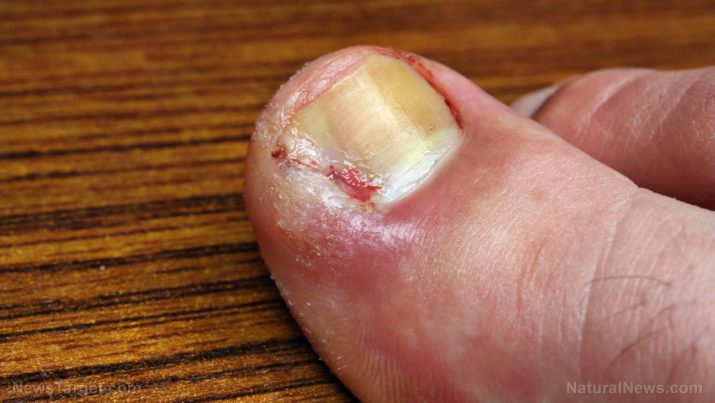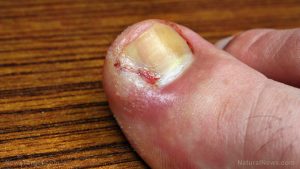
Onychomycosis – causes, side effects and treatments at NaturalPedia.com
Wednesday, June 27, 2018 by Michelle Simmons
http://www.naturalpedia.com/onychomycosis-causes-side-effects-and-treatments-at-naturalpedia-com.html

Onychomycosis is also referred to as fungal infection of the nails. This condition is increasingly common with increased age and rarely affects children. Onychomycosis can be caused by dermatophytes, yeasts, and molds. In onychomycosis, one or more toenails and/or fingernails are affected; although it most often affects the great toenail or the little toenail. Onychomycosis is divided into five main subtypes:
- Distal lateral subungual onychomycosis (DLSO)
- White superficial onychomycosis (WSO)
- Proximal subungual onychomycosis (PSO)
- Endonyx onychomycosis (EO)
- Candidal onychomycosis
Total dystrophic onychomycosis is the term used to refer to the most advanced form of any subtype.

Known symptoms of onychomycosis
The signs of onychomycosis may include discoloration of the nail to white, black, yellow, or green, thickening of the nail, brittle nails that chip or break easily, discoloration of nail bed and skin around the nail to white or yellow, dry or scaly skin around the nail, and a foul smell. People with onychomycosis may also experience dermatophytids, which are skin lesions that affect another part of the body away from the nail area. It is thought of as an allergic skin reaction due to exposure to the nail fungus. Dermatophytids are usually characterized as a red rash on the skin that can cause significant itchiness.
Onychomycosis can cause pain, discomfort, and disfigurement and may result in serious physical and occupational limitations, as well as reducing quality of life.
Body systems harmed by onychomycosis
The body system harmed by onychomycosis is the integumentary system.
List of foods or nutrients that prevent onychomycosis
Below is a list of antifungal foods that can help prevent onychomycosis:
- Apple cider vinegar
- Cayenne pepper
- Coconut oil
- Fruits, such as white nectarines, white peaches, bananas, brown pears, and dates
- Garlic
- Ginger
- Gluten-free whole grains
- Pumpkin seeds
- Vegetables like cabbage, spinach, cucumber, tomatoes, onions, turnips, parsnips, rutabagas, and broccoli
- Yogurt
Treatments, management plans for onychomycosis
Natural treatments for onychomycosis include putting tea tree oil or grapefruit seed extract on the affected nails twice a day for a minimum of two months and eating one or two cloves of raw garlic daily. To prevent onychomycosis, keep your hands and feet dry; wash socks with disinfectant; soak your nails in a vinegar solution; protect your nails from trauma; boost your immune system; and ensure safe and hygienic manicure and pedicure practice.
Where to learn more
- Are You at Risk for Toenail Fungus?
- For Healthy Nails – Nail Fungus Once and for All
- Our Fingernails Give Us a Window to Our Health
- What You Can Do About Diabetes-Related Fungal Infections
- Your nails and your overall health (press release)
Summary
Onychomycosis is a fungal infection of the toenails and/or fingernails.
Onychomycosis causes discoloration of the nail to white, black, yellow, or green, thickening of the nail, brittle nails that chip or break easily, discoloration of nail bed and skin around the nail to white or yellow, dry or scaly skin around the nail, and a foul smell.
Foods that prevent onychomycosis include apple cider vinegar, cayenne pepper, coconut oil, fruits, garlic, ginger, gluten-free whole grains, pumpkin seeds, vegetables, and yogurt.
Onychomycosis can be treated naturally by applying tea tree oil or grapefruit seed extract on the affected nails twice a day for a minimum of two months or eating one or two cloves of raw garlic daily.
Sources include:
Tagged Under: Tags: Onychomycosis





